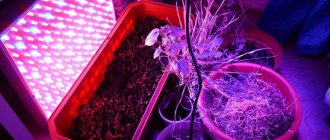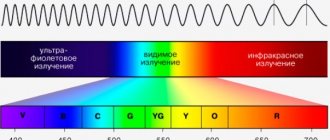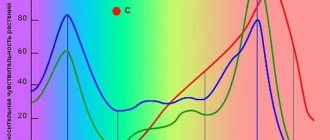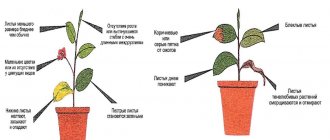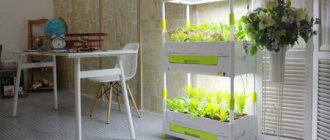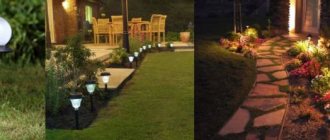To create conditions for plants that allow them to develop properly, it is necessary to install proper lighting. LED lighting lamps are the most effective option, providing flowers or vegetables with the required spectrum and being an excellent alternative to natural light.
LED lighting - main characteristics
The advantages of using LED lighting include, first of all, a long service life, no heating during operation, and low electrical energy consumption. In addition, you can create lighting of the required spectrum - for example, using blue and red LEDs.
LED lighting for plants
To create conditions that are natural and favorable for growing, the illumination should be no less than:
- 700 – 1,000 lux – for plants growing in the shade;
- 1,000 - 2,000 lux - for plants that can grow in the shade and prefer diffused light;
- 2,500 lux and more - for light-loving plants.
To calculate a lighting system using LEDs, you need to know the following quantities:
- Illuminated area;
- Installation height of lamps;
- Type of plant (relation to light).
Lighting power is determined in watts per m2. The most useful light waves for plant development are blue and red. Depending on the parameters, light waves have different effects on plants, namely:
| Item no. | Light waves | Wave range, nm | Impact on plants |
| 1 | Ultraviolet | 400 | Promotes resin formation |
| 2 | Infrared | 730 | Helps produce chlorophyll |
| 3 | Blue color | 430 | Helps produce chlorophyll |
| 4 | Red color | 660 | Helps produce chlorophyll |
Blue LEDs
LEDs of this color emit a luminous flux of the blue, blue-violet spectrum, lying in the range from 430 to 490 nm. This light spectrum has a positive effect on plants in the initial growth stage.
Red LEDs
LEDs of this color emit a luminous flux of the red, red-orange spectrum, lying in the range from 600 to 780 nm. This light spectrum has a positive effect on plants at the stage of fruit development and leaf growth.
Full Spectrum LEDs
Phyto LEDs, full spectrum LEDs, are devices that emit an extended range of light waves from a single light source.
Phyto LEDs
Advantages of this type of device:
- The emitted luminous flux is close in characteristics to natural sunlight (range from 400 to 840 nm);
- Suitable for all stages of plant growing;
- Allows you to simultaneously illuminate plants of different development stages.
- The efficiency of use is higher than when using individual LEDs with a narrow spectrum of light emission (1.9 times) and LED assemblies (1.2 times).
How to light plants with LED lamps
Suppose you need to illuminate a flower that tolerates shadow well. According to the above classification, 5000 lux of light is enough for him, and he will live for some time under illumination 10 times less, that is, 500 lux. According to the current lighting standard, the light level in the office of a person working at a computer should be only 500 lux, which means that person can put such a flower on his desk. For every square meter of office there will be 500 lumens of light, which means the lighting intensity will be 500 lux.
Next, let's say you buy an LED grow light that produces 500 lumens of light. But there is one more thing to remember: the light bulb will not illuminate the entire plant with such intensity, but only the top, provided that you bring the plant closer to the light bulb (no closer than 10 cm, otherwise it may catch fire). You can illuminate a larger area, but then the light bulb needs to be installed higher. This means the amount of light that the plant receives will be inversely proportional to the square of the distance between the light bulb and the pot.
Simply put, this means that if the bulb is 2 times higher above the plant, it will illuminate a larger area, but 4 times less light will reach the plant!
This is the dependence of illumination on the distance to the light bulb. Therefore, if you want to properly illuminate the plants, you will have to hang a sufficient LED bulb above each pot, or just one, but then a really powerful one. Light the plants from the very top. A lamp that illuminates pots from the side or at an angle will cause plants to grow crookedly in search of light and lean towards it.
Types of LED light sources
Currently, a large number of different types of LED lamps (luminaires) are produced, which can be classified as:
- In the form of a pipe - convenient to use when growing plants at home;
- Single spotlight - there are various designs, used for individual use;
- LED panel - used to illuminate a large number of plants, they come in rectangular shape;
- LED strip is universal in use and easy to install. When making LED strips used to illuminate plants, the number of blue LEDs to red ones is 10/3, 15/5, 5/1, respectively. In LED phyto lamps, the proportion of red color is 60-80%, and blue – 40-20%. ;
- LED floodlight is a device for industrial use. It is possible to illuminate large areas from a remote distance.
LEDs are narrowly focused light sources, which determines the conditions for their installation. When installing luminaires, you should consider:
- Plant height;
- Arrangement of plants (distance between them).
Which phytolamp to choose
There are several types of phytolamps:
- sodium,
- luminescent,
- induction,
- LED
Each type has both its advantages and disadvantages.
Sodium lamps have a highly efficient lighting system, they have a long service life, they are economical, but they are not suitable for installation in residential premises. Bright light spreads in all directions, blinding and causing eye diseases. Such lamps require special ballasts; they cannot be plugged directly into an outlet. But the main disadvantage for plants is the lack of waves in the blue part of the spectrum.
Fluorescent phytolamps are used quite often when growing seedlings. They are relatively inexpensive, provide uniform illumination, and are economical to operate. They have a low temperature when heated - the lamp can be brought closer to the seedlings without fear of burns. The luminescence spectrum is close to the optimal range for plants. But some consider their light to be overly bright and not comfortable for the eyes.
Induction phytolamps are very durable, their service life can reach 15-20 years. The emission spectrum of such lamps is universal and suitable for successfully growing plants. The electrodes of such lamps do not burn out, so the luminous flux does not noticeably decrease over time. Low heating of the bulb allows you to reduce the distance from the lamp to the plant. The disadvantage is the high cost of such lamps.
LED phytolamps are especially popular among summer residents. Such lamps have high efficiency and low energy consumption, the luminescence spectrum and power can be adjusted, and the service life reaches 50,000 hours. Such lamps practically do not heat up, are environmentally friendly and do not contain harmful and dangerous substances. Their disadvantage is that during operation a power loss may occur. Such lamps are more expensive than fluorescent lamps, but last on average 5-10 times longer.
LED Lighting Manufacturers
Currently, the light source market offers a fairly wide range of LED lamps that differ in design, power, type of performance and their manufacturer. The most famous are:
"Komled", Kazan, Russia is a manufacturing company specializing in the production of LED lamps for various purposes. For plant lighting the following are available:
- “Optima F” lamps – power from 38.0 to 220 W and luminous flux from 3036 to 18216 Lm, respectively;
- “Line F” lamps – from 10.0 to 65.0 W and luminous flux from 1331 to 9318 Lm, respectively.
"SVETOTRONIKA", St. Petersburg, Russia - the company produces a wide range of LED lamps of various designs and purposes. For lighting plants, lamps with a power of 50 Watt are produced, with a luminous flux of 79.3 µmol/s lumens and a color temperature of 450 nm - 32% (8 diodes) and 660 nm - 68% (16 diodes):
- SVT-BIO L-50-45;
- SVT-BIO L-50;
- SVT-BIO L-50-20×50;
- SVT-BIO L-50-10×60;
- SVT-BIO L-50-25;
Largest foreign manufacturers:
- Nichia Corporation, Japan;
- Samsung LED, South Korea;
- Osram Opto Semiconductors, Germany;
- LG Innotek, South Korea;
- Seoul Semiconductor, South Korea;
In addition to those listed above, LEDs from lesser-known domestic and foreign manufacturers are also available on the domestic market, so anyone can choose an LED lamp in accordance with the requirements for it.
Red and blue are the favorite colors of plants
More and more gardeners are starting to grow seedlings with artificial plant lighting. For this purpose, even special phytolamps have appeared on sale. How to navigate their diversity and use these light sources correctly?
Why do you need to add light to plants at all? Due to lack of light, the process of photosynthesis slows down, the plants become very elongated, are stunted in growth, their bud formation stops, and the leaves become pale green. That is, the quality of seedlings is greatly reduced. In industrial greenhouses, so-called sodium lamps are installed as an additional light source for plants, which are not recommended for use in everyday life. The most advanced gardeners tried to illuminate seedlings with ordinary fluorescent lamps, the so-called fluorescent lamps. But their radiation spectrum does not fully meet the needs of plants. By the way, because of this, for example, incandescent lamps are generally not suitable for plants. Until recently, most gardeners had virtually no choice, so they grew plants without lighting, placed the seedlings on the windowsill, and at the very least they grew there. Everything changed when manufacturers began mass-producing phytolamps - LED light sources with special light filters.
LED lights for seedlings have become a real godsend for gardeners: low power consumption, do not heat the air, and can produce any light spectrum. But more and more often they are becoming a reason for disappointment - the price is too high, they do not provide the characteristics declared by the manufacturer.
— I am often asked: are LEDs good or bad for illuminating plants? And you don’t know what to answer to this. There are excellent LED phytolamps, but 80 percent of what is offered on the market are products imported from China, which have unclear emission spectra, it is unclear what the temperature is, it seems that someone just mixed LEDs and sent them to us , says head of phytolighting projects Artyom Melentyev .
The disadvantage of phytolamps is that their visible spectrum is unpleasant to the human eye. Photo: Alexey Kunilov
According to him, when choosing a phytolamp, first of all, you need to pay attention to three factors: the radiation spectrum declared by the manufacturer, the emitted power, and the presence of good heat dissipation. LED lamps for plants most often combine two spectrums - red and blue. Mixing these two colors produces purple, which is unpleasant to the human eye, but beneficial to plants.
“In the initial phase of growth, plants need the blue spectrum more, while red is almost not used, then they are balanced, and during the flowering period red should already predominate by 80 percent,” says Artyom Melentyev.
But the need of plants covers a wider part of the spectrum, including yellow-green, which manufacturers often do not include in phytolamps, but is present in ordinary LED lamps for lighting. According to Artyom Melentyev, in such cases you can simply supplement the lighting with a regular white lamp.
It is better to choose phytolamps with higher power. The rule here is: “you can’t spoil porridge with oil.” The plants themselves will tell you how to adjust the light. If the palm placed in front of the leaves feels heat from the lamp, it should be raised. If the leaves of the plants begin to close together and take a vertical position, then limit the lighting time or remove some of the lamps. Each gardener must determine the optimal quality of additional lighting experimentally. On average, plants need about 16 hours of additional lighting in the absence of direct sunlight.
The lamp itself will tell you about the quality of the heat sink: if it gets hot, its temperature is noticeably higher than the usual 50 degrees for such devices, and it will not work for a long time. Don't buy these lamps again.
And also, when trying to give a lot of light to seedlings, do not overdo it. At night, plants still need to sleep.
- Published in No. 38 of March 3, 2018
Plot
"House. Garden. Vegetable garden" Features and secrets of gardening in the Middle Urals.
DIY LED lighting for plants
LEDs for creating a lamp
If you have electrical installation skills, free time and desire, you can make LED lighting yourself, so to make a phyto lamp you will need:
- Fluorescent lamp housing;
- Power supply 220/12 V, you can use a used one;
- LED matrices or LEDs;
- Connecting wires (copper, cross-section not lower than 0.75 mm2);
- Cooling plate (cooler);
- Aluminum strip.
LEDs of selected colors (the colors and their relationships are given above) are attached to the LED matrix or connected in parallel, using connecting wires or soldering, in accordance with the polarity of the devices.
The number of LEDs connected (their total power) must correspond to the power of the power supply. Mounting is carried out on the cooling plate. Also, to cool the LEDs, ventilation holes are made in the lamp body by drilling. In the case of using an LED matrix, the light source is glued to an aluminum strip, which is placed inside the lamp body.
How to choose a phytolamp by shape
Most often, phytolamps come in two shapes – linear and round. The first type of source can be either LED or fluorescent. The second is LED (light bulbs with E27 socket). These lamps are convenient because, having bought one phytolamp with a classic base, you can screw it into a regular table lamp.
The advantage of linear models is the uniform distribution of light flux. The disadvantages include the relatively large sizes.
Before you buy a phytolamp, decide how you will place the plants under it.
If they will stand in the shape of a rectangle, for example, on a windowsill, choose a linear shape. If it is in the shape of a circle or square, a round one is better.
A small round lamp is more convenient to use for small plants in pots or a small number of seedlings. If there are a lot of seedlings, you will have to use several round lamps. Or give preference to a linear device.
There are also:
- transformable lamps (“petals” can be moved apart to increase the lighting area, or directed to one point to create an area with the maximum amount of light);
- bayonet phytolights (inserted directly into a pot with a plant, but limited in height adjustment);
- table phytolights (elongated, but in the form of a table lamp);
- LED phytolamp (attached to the surface using an adhesive base, much longer than a conventional linear phytolamp, you can wrap a significant part of the rack with seedlings);
- spotlights (convenient for greenhouses);
- ready-made mini-gardens (structures with lighting at the top and pots at the bottom).
Aquarium lighting with LEDs
For the growth and development of tropical aquarium plants, lighting for about 10 hours a day is also necessary. LED designs make it possible to arrange lighting, the elements of which can be replaced every few years.
- Diode lamps can be mounted on the top cover of the aquarium, or can be placed in a special box above it. To calculate the required number of lamps, take into account the depth and area of the aquarium.
- Using LED strips, they create lighting with the ability to automatically turn on and off using an electric timer. For example, blue diodes may turn on at night, and red ones during the day.
The lamps must be equipped with a heat removal system, otherwise the water in the aquarium will bloom. Also, too bright lighting is not suitable for fish.
If you need to select LED lamps that will promote the development of plants, the setting of buds and fruits, you can contact the specialists of our company, who will calculate the required power and number of lamps, and also recommend reliable products presented in the online store catalog.
